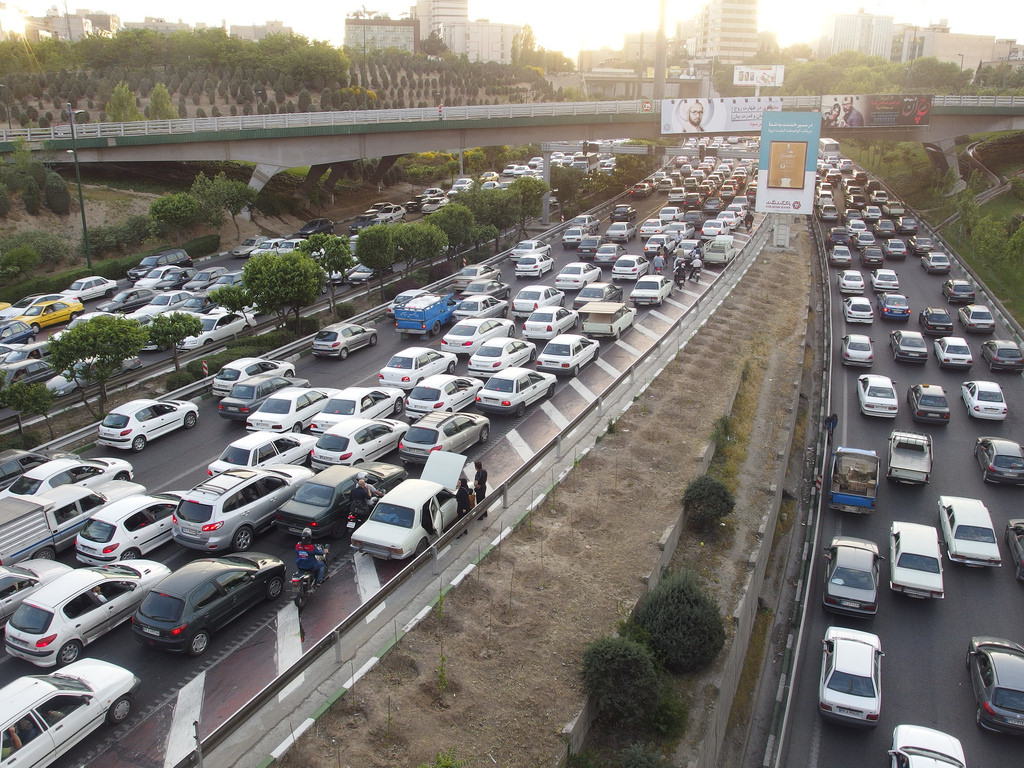Has Tehran come to a standstill because of the torturous traffic? Do its roads in all four directions, from early morning to late in the night, look like a warzone? Ask the exhausted and resentful folks who commute to work in this city.
While the people and environmentalists continue to challenge policy makers and urban planners with regard to the permanently clogged roads in every major city, government officials and local automakers, ignoring the monumental health and environmental cost to the masses, never stop basking in “Iran’s booming auto industry”.
From their point of view time, money and energy is geared to increasing auto production “in the interest of the economy and creating jobs.” Few if any decision makers care to explain to the people what actually they have achieved in the critical realm of public transport infrastructure.
Truth be said, there has been some improvement with the expansion of the subway system, new highways, BRTs, odd-even plans and special traffic restrictions in the central parts of Tehran. It is good but simply not enough. Why? Everyday something close to 3,500 new cars are produced by the dysfunctional state-backed local carmakers the vast majority of which are sold in Tehran.
For all practical purposes Tehran has become one big parking lot and things are expected to get much worse before they get any better. More than four million vehicles commute on Tehran’s roads, a figure that according to a former traffic deputy at Tehran Municipality is eight times over and above the nominal capacity.
Maziar Hosseini says, “Tehran streets and freeways can hardly handle more than 750,000 vehicles. This is while, every day more than four million cars ply the capital’s overcrowded roads,” ISNA reported.
In Tehran, the worsening traffic congestion has become a torture because the public transport system is not enough to meet the growing needs of the bustling metropolis of 12 million people.
Over the past three decades the capital has expanded in all four directions to the extent that on the northern flank high rise towers have crept into the mountains while villas for the nouveau rich have been built at the foothills and near the Alborz Mountain range
According to official figures, the daily influx of people, mainly commuters, brings the ‘daylight’ population of Tehran up to more than 15 million, more than a fifth of the country’s population of 80 million!
The municipality estimates that 19 million daily trips are made in the capital on any working day (and night). Lack of enough and efficient public transport is the primary reason behind the torture 24/7.
No Solution in Sight
Hosseini concurs that “Tehran’s traffic condition has become unbearable. There is traffic congestion in every major city in the world, but it is controlled and managed.”
What can and should he done to address this huge problem? No one knows. Will the municipalities stand up?
The former TM official says, “Many of the roadways in the city are old and were not built for today’s traffic. Simply put, many of the roads date back to the time when there were not many motor vehicles on the streets” and Tehran’s population was in the region of three million.
During the past ten years, the number of cars commuting on Tehran’s roads has spiked — the number was 1.5 million in 2005.
By the end of 2014, there were 213 motor vehicles per 1,000 people in Iran. According to latest statistics released by the Ministry of Industries, the figure now is 250 in Iran. The number is much higher in Tehran and estimated to be 307 cars per 1,000 citizens.
During the first seven months of the current fiscal that ends in March, 772,120 cars were produced in Iran, which means every day over 3,600 new cars enter the country’s roads.
In August, the government introduced a scrappage scheme which was aimed at decreasing the number of aging vehicles and replacing them with better cars.
One of the other professed goals of the plan was to help reduce the worsening air pollution caused largely by the exhaust fumes. However, in October, the government of President Hassan Rouhani put an end to the auto scrappage scheme with the Minister of Industries Mohammad Shariatmadari saying that “the plan would have a major negative impact on the domestic market and lead to higher prices.”
According to the scheme for each vehicle with fuel consumption over 8.5 liters per 100 kilometers, the auto company was required to pay the government 25 million rials ($650). Hypothetically, the money was to be used for removing the dilapidated gas guzzlers from the roads.
The early death of the scheme was sound of music for the local automakers, who saw the way cleared to continue their dodgy operations.


